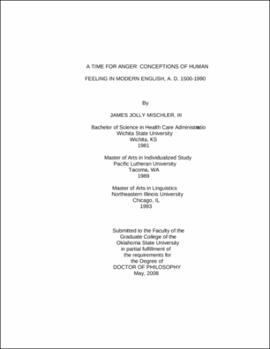| dc.contributor.advisor | Moder, Carol Lynn | |
| dc.contributor.author | Mischler, James Jolly, III | |
| dc.date.accessioned | 2013-11-26T08:29:34Z | |
| dc.date.available | 2013-11-26T08:29:34Z | |
| dc.date.issued | 2008-05 | |
| dc.identifier.uri | https://hdl.handle.net/11244/7077 | |
| dc.description.abstract | Scope and Method of Study: The presentation reports on an interdisciplinary, diachronic study designed to delineate the influence of historical cultural knowledge over time on the conceptualization of ANGER in English metaphoric expressions. Non-linguistic data on the Four Humors medical model was collected from primary sources of the historical period under study; then, metaphoric expressions of anger were collected from two compiled corpora of historical English texts. The two corpora were the Penn-Helsinki corpus and the ARCHER corpus. The corpora were searched for two metaphoric expressions analyzed in previous studies of the conceptual metaphor of ANGER, including "Her blood boiled" and "He vented his spleen." The 49 metaphoric expressions collected were analyzed for the underlying conceptualization of ANGER and the influence of the Four Humors model on the conceptualization. | |
| dc.description.abstract | Findings and Conclusions: The results showed that the conceptual metaphor of ANGER is a dimension (Langacker, 1987) within the conceptual metaphor of EMOTION; I argue that this CM is a basic-level conceptualization and reasonably accounts for a wide variety of human emotional experience. For example, the heat scale related to the CM of ANGER (Lakoff & Kövecses, 1987) is part of a more general temperature scale found in the CM of EMOTION which links various emotions to points on the scale, ranging from hot to cold. Likewise, the CM of EMOTION includes a CONTROL scale that accounts for the entailment of the loss of control in certain metaphoric expressions of anger and also the maintenance of control in other anger expressions. Finally, both scales were found to be consistent with the Four Humors model data. In sum, the CM of EMOTION is a domain matrix which links together human emotions in a complex set of conceptual, cultural, and historical relations. | |
| dc.format | application/pdf | |
| dc.language | en_US | |
| dc.rights | Copyright is held by the author who has granted the Oklahoma State University Library the non-exclusive right to share this material in its institutional repository. Contact Digital Library Services at lib-dls@okstate.edu or 405-744-9161 for the permission policy on the use, reproduction or distribution of this material. | |
| dc.title | Time for anger: Conceptions of human feeling in modern English, A. D. 1500-1990 | |
| dc.contributor.committeeMember | Garzon, Susan | |
| dc.contributor.committeeMember | Halleck, Gene B. | |
| dc.contributor.committeeMember | Damron, Rebecca L. | |
| dc.contributor.committeeMember | Kennison, Shelia M. | |
| osu.filename | MischlerIII_okstate_0664D_2745.pdf | |
| osu.accesstype | Open Access | |
| dc.type.genre | Dissertation | |
| dc.type.material | Text | |
| dc.subject.keywords | metaphor | |
| dc.subject.keywords | conceptual | |
| dc.subject.keywords | English | |
| dc.subject.keywords | historical | |
| thesis.degree.discipline | English | |
| thesis.degree.grantor | Oklahoma State University | |
